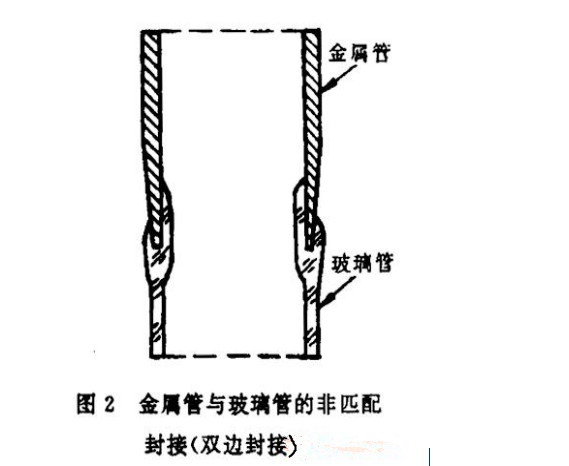Glass and metal sealing
The most common glass-to-metal seals are electrode leads and pipe-shaped glass-to-metal seals. This kind of sealing is divided into matching sealing and non-matching sealing. Matching sealing refers to the sealing between glass and metal with similar expansion coefficients, and the internal stress at the sealing place is small; non-matching sealing refers to the sealing between glass and metal with large expansion coefficients. The internal stress is large. In order to eliminate the internal stress caused by the large difference between the expansion coefficient of glass and metal, generally a thin-walled metal tube with good ductility is used to seal the glass, and the internal stress is eliminated by the plastic deformation of the metal.

Figure 2: Non-matching sealing of metal tube and glass tube
Figure 2 is a non-matching sealing form of a metal tube and a glass tube. The wall of the metal tube is gradually thinned at the sealing point to facilitate deformation, and the thinning area is about twice the length of the sealing area. This kind of sealing is generally divided into external sealing (glass is only welded on the outside of the metal pipe wall), internal sealing (glass is only welded on the inside of the metal pipe wall), and bilateral sealing (glass covers the metal pipe from the inner and outer sides). Wall) three kinds. In the case of bilateral sealing, the sealing length of the inner glass is preferably twice that of the outer. This type of sealing does not stand up to repeated temperature fluctuations. For example, when sealing copper and glass, if the temperature swing is from room temperature to 400°C, it can only be used hundreds of times.


 Add: No.3, Tengfeng No.5 Road, Fenghuang community, Fuyong street, Bao'an District, Shenzhen City, Guangdong Province
Add: No.3, Tengfeng No.5 Road, Fenghuang community, Fuyong street, Bao'an District, Shenzhen City, Guangdong Province Mr. Xu +86 13725583800 Mr. Liu +86 18665377610
Mr. Xu +86 13725583800 Mr. Liu +86 18665377610  303728587@qq.com 314473039@qq.com 387700252@qq.com
303728587@qq.com 314473039@qq.com 387700252@qq.com
